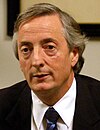Elections in Argentina, 2003
|
|
|||||||||||||||||||||||||||||||||||||
|---|---|---|---|---|---|---|---|---|---|---|---|---|---|---|---|---|---|---|---|---|---|---|---|---|---|---|---|---|---|---|---|---|---|---|---|---|---|
|
|||||||||||||||||||||||||||||||||||||
| Registered | 25,481,410 | ||||||||||||||||||||||||||||||||||||
| Turnout | 78.22% | ||||||||||||||||||||||||||||||||||||
|
|||||||||||||||||||||||||||||||||||||

|
|||||||||||||||||||||||||||||||||||||
|
|||||||||||||||||||||||||||||||||||||
Eduardo Duhalde
Justicialist Party
Néstor Kirchner
Justicialist Party
Argentina held presidential and parliamentary elections on Sunday, April 27, 2003. Turnout was 78.2%. No one presidential candidate gained enough votes to win outright, but the scheduled runoff was canceled when first-round winner Carlos Menem pulled out, handing the presidency to runner-up Néstor Kirchner.
For the first time since the return of democracy in 1983, the Justicialist Party (PJ) failed to agree on a single presidential candidate. Three credible Peronist candidates ran in the election: center-right former President Carlos Menem, center-left Santa Cruz Province Governor Néstor Kirchner, and centrist San Luis Province Former president Adolfo Rodríguez Saá. None were officially supported by the party, though President Eduardo Duhalde publicly endorsed Governor Kirchner on January 15, 2003. The PJ suspended its January 24 convention, opting to allow the three contenders to run on the Peronist mantle. None of the candidates were allowed to use the traditional Peronist iconography in detriment of the others.
For the first time since 1916, the UCR did not field a presidential candidate. After the political collapse at the peak of the economic crisis that led to the resignation of President Fernando de la Rúa at the end of 2001, popular support for the UCR was at historically low levels. Two strong former members of the UCR founded parties based on their politics: Congresswoman Elisa Carrió founded a left-of-center party, the ARI, and economist Ricardo López Murphy founded a right-wing one, Recrear.
...
Wikipedia



